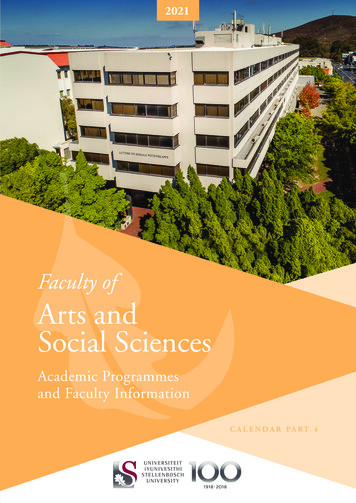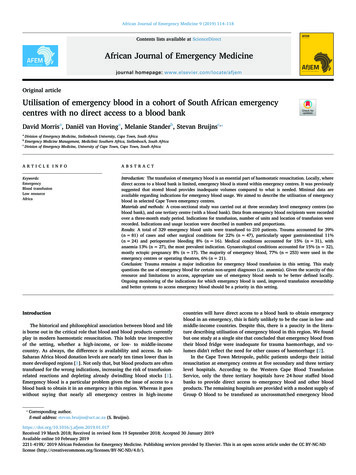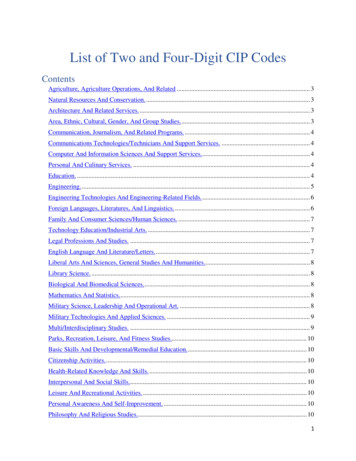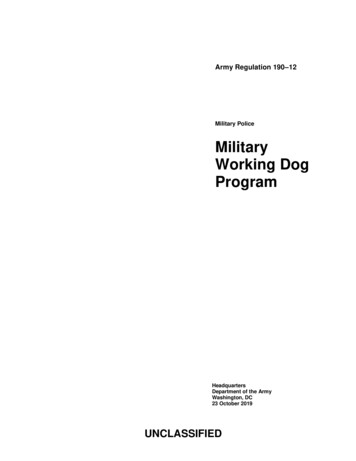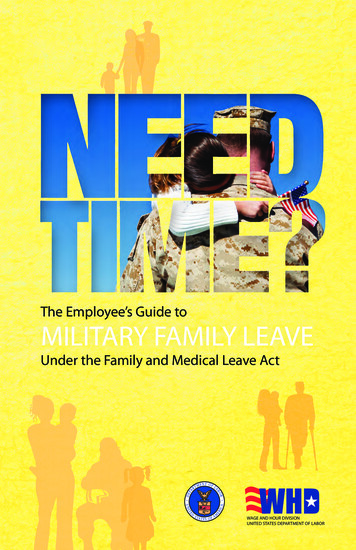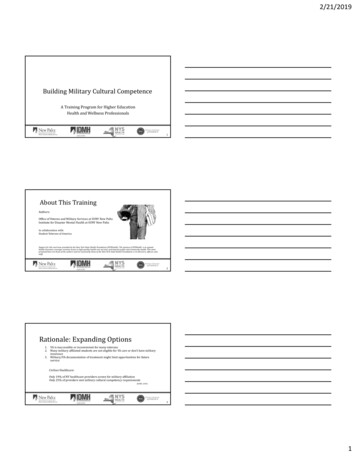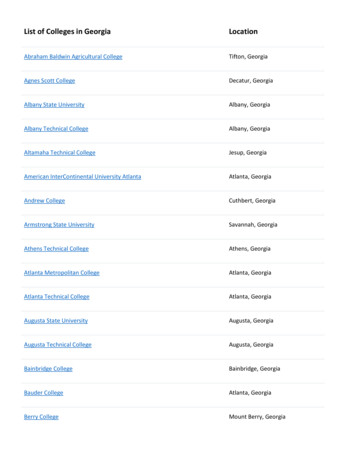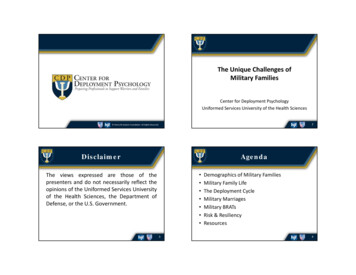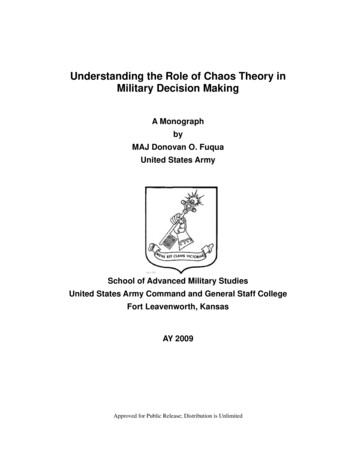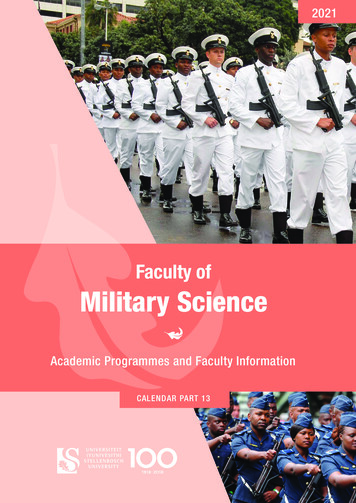
Transcription
2021Faculty ofMilitary ScienceAcademic Programmes and Faculty InformationCALENDAR PART 13
Military ScienceAccuracy, liability and changes Stellenbosch University has taken reasonable care to ensure that the informationprovided in the Calendar parts is as accurate and complete as possible.Please note, however, that the University’s Council and Senate accept no liability for anyincorrect information in the Calendar parts.The University reserves the right to change the Calendar parts at any time whennecessary.Please note that the information in this Calendar part, and also in the other Calendar parts, is subjectto change, as and when necessary, for as long as uncertainty regarding the Covid-19 situationpersists.The division of the Calendar PartPart 1Part 2Part 3Part 4Part 5Part 6Part 7Part 8Part 9Part 10Part 11Part 12Part 13The Calendar is divided into 13 parts.Part 1, 2 and 3 of the Calendar contain general information applicable to all students.Make sure that you understand all provisions in Part 1 (General) of the Calendar thatapply to you.Part 4 to 13 of the Calendar are the faculty Calendar parts.CalendarGeneralBursaries and LoansStudent FeesArts and Social nomic and Management SciencesEngineeringMedicine and Health SciencesMilitary ScienceAvailability of the Calendar parts The electronic versions of the Calendar parts are available at www.sun.ac.za/Calendar.There are English and Afrikaans (Part 1 to 12) copies available.i
Military ScienceTable of ContentsHow to use this Calendar part . 11. How to locate information . 11.1 Prospective undergraduate students . 11.2 Prospective postgraduate students . 11.3 Registered undergraduate students. 21.4 Registered postgraduate students . 21.5 Prospective students for the PhD in Military Science degree. 2General information . 31. History and functions of the Faculty . 31.1 History . 31.2 Functions . 32. Qualifications offered at the Faculty . 43. Other services offered by Faculty. 43.1 Academic development . 43.2 Language service . 44. How to communicate with the Faculty. 54.1 Postal and physical address of the Faculty . 54.2 Contact details of the Faculty . 55. How to communicate with the University . 55.1 Using your student number . 55.2 Contact details of the University . 65.3 Useful telephone numbers . 66. Language at the University . 67. The Faculty’s implementation of the Language Policy. 7Undergraduate programmes . 81. Bachelor’s of Military Science . 82. Admission to BMil programmes. 82.1 Application and selection . 82.2 Admission requirements by way of a Senior Certificate (up until 2008) . 82.3 Admission requirements by way of a National Senior Certificate (as from 2009) . 92.4 Admission requirements by way of the Preparatory Certificate in Military Studies . 103. General provisions . 104. Examination and promotion regulations . 104.1 Reassessment . 10ii
Military Science4.2 Determination of final mark . 114.3 Admission to final examinations. 114.4 Proceeding to a module . 114.5 Dean’s concession examination . 115. Certificates . 125.1 Preparatory Certificate in Military Studies (PCMS). 125.2 Higher Certificate in Military Studies (HCMS) . 135.2.1. HCMS in Human and Organisation Development. 135.2.2. HCMS in Organisation and Resource Management . 155.2.3. HCMS in Security and Africa Studies . 175.2.4. HCMS in Military Technology . 195.2.5. HCMS in Technology and Defence Management . 216. Bachelor of Military Science (BMil). 246.1. BMil in Human and Organisation Development . 246.2. BMil in Organisation and Resource Management . 276.3. BMil in Security and Africa Studies . 306.4. BMil in Defence Intelligence Studies (This programme will be available in due time) . 336.5. BMil in Technology . 376.6. BMil in Technology and Defence Management . 41Postgraduate programmes . 451. Postgraduate Diploma in Defence Studies (PGDip) . 452. Honours degrees . 452.1. Bachelor of Military Science with Honours (BMilHons). 452.1.1. BMilHons in Industrial Psychology . 462.1.2. BMilHons in Military Geography . 462.1.3. BMilHons in Military History . 472.1.4. BMilHons in Military Management . 472.1.5. BMilHons in Strategic Studies . 482.1.6. BMilHons in Organisation and Resource Management. 492.1.7. BMilHons in Public and Development Management (PDM) . 502.1.8. BMilHons in Security and Africa Studies . 512.1.9. BMilHons in Technology . 513. Master’s degrees . 533.1. Master of Military Science (MMil) . 533.1.1. MMil in Military Science (Research) . 533.1.2. MMil in Military Geography . 543.1.3. MMil in Military History . 55iii
Military Science3.1.4. MMil in Strategic Studies . 563.1.5. MMil in Organisation and Resource Management . 583.1.6. MMil in Security and Africa Studies. 583.1.7. MMil in Technology . 603.2. MPhil in Defence Studies. 604. Doctoral degrees . 614.1. PhD in Military Science . 61Subjects, modules and module content . 62Research and service bodies. 1061. Centre for Military Studies .1061.1. Nature . 1061.2. Role. 1061.3. Objectives . 1061.4. Projects . 1061.5. Address . 1072. Telematic Services Department .1072.1. The aim of Telematic Services . 1072.2. Functions of Telematic Services . 1072.3. Programmes offered through Telematic Services . 1072.4. Address . 108Alphabetical list of undergraduate subjects . 109iv
Military ScienceHow to use this Calendar partThis section gives you guidelines for finding particular information in the different chapters in thisCalendar part. Consult the table of contents for the page numbers of the chapters referred to below.1. How to locate information1.1 Prospective undergraduate students The chapter “General Information” contains information about:o communication with the Faculty and University, including an explanation of theconcept “student number” as well as contact details for directing importantenquiries;o the University’s Language Policy and Plan and how they are is applied by theFaculty; ando the degree programmes that you can enrol for and the qualifications that you canobtain, as well as important provisions regarding programmes and modules.The chapter “Undergraduate Programmes” contains information about:o the minimum admission requirements for the various study programmes;o the Faculty’s undergraduate study programmes; ando the subjects and modules that you must take per academic year for the differentstudy programmes, with choices where applicable.The chapter “Subjects, Modules and Module Contents” contains:o an explanation of subjects as opposed to modules;o an explanation of the different digits used for numbering modules in the chapter“Undergraduate Programmes”;o definitions of the language specifications of modules; ando definitions of prerequisite pass modules, prerequisite modules and corequisitemodules.An alphabetical list of undergraduate subjects has been included in the back of thisCalendar part.1.2 Prospective postgraduate students The chapter “General Information” contains information about:o communication with the Faculty and the University, including an explanation of theconcept “student number” as well as contact details for referring importantenquiries; ando the University’s Language Policy and Plan and how they are applied by the Faculty.The chapter “Postgraduate Programmes” contains information about:o the Faculty’s postgraduate study programmes;o the minimum admission requirements for the various study programmes;1
Military Scienceoospecific closing dates for applications, and other relevant information (e.g. selectionfor admission); andthe subjects and modules that you must take per academic year for the differentstudy programmes, with choices where applicable.1.3 Registered undergraduate students The chapter “General Information” contains information about:o communication with the Faculty and the University, with contact details where forreferring important enquiries to; ando the University’s Language Policy and Plan and how they are applied by the Faculty;The chapter “Undergraduate Programmes” contains information about:o the Faculty’s undergraduate study programmes; ando the subjects and modules that you must take per academic year for the differentstudy programmes, with choices where applicable.The chapter “Subjects, Modules and Module Contents” contains information about:o an explanation of subjects as opposed to modules;o an explanation of the different digits used for numbering modules in the chapter“Undergraduate Programmes”;o the abbreviations and definitions used to indicate the teaching loads of individualmodules;o an indication at each module of its teaching load;o definitions of the language specifications of modules, as well as an indication ateach module of its language specification;o definitions of prerequisite pass modules, prerequisite modules and corequisitemodules, as well as an indication at each module of the requirements that apply toit, if any; ando the aims, content and outcomes of each individual module.An alphabetical list of undergraduate subjects has been included in the back of thisCalendar part.1.4 Registered postgraduate students The chapter “Postgraduate Programmes” contains information about:o the Faculty’s postgraduate study programmes; ando the subjects and modules that you must take per academic year for the differentstudy programmes, with choices where applicable.1.5 Prospective students for the PhD in Military Science degree The chapter “Postgraduate Programmes” contains information about:o the doctoral programme of study that is offered; ando the minimum admission requirements for the doctoral programme of study.2
Military ScienceGeneral information1. History and functions of the Faculty1.1. HistoryThe Military Academy was established on 1 April 1950 under the auspices of the University ofPretoria, as a branch of the SA Military College (now the SA Army College) at Voortrekkerhoogte(now Thaba Tshwane). In 1953, the Military Academy would move to Saldanha, under thetrusteeship of Stellenbosch University, from which institution successful candidates would receivea BMil degree. In January 1961, the Academy became a faculty in its own right – the Faculty ofMilitary Science of Stellenbosch University.1.2. FunctionsStellenbosch University is the custodian of the Faculty of Military Science through a contractualagreement with the South African Department of Defence (DoD). The Faculty is located withinthe SA Military Academy in Saldanha Bay on the West Coast of South Africa. On our Campus,civilian and uniform members work together and learners are members of SA Army, SA Navy, SAAir Force, SA Military Health Services and members of the broader DoD. We develop the futuremilitary leaders of South Africa and our international partners such as Botswana, France,Mozambique and Namibia.We are the only Faculty of Military Science in South Africa and our Faculty members have theopportunity to develop expert knowledge in their respective academic disciplines. Our academicprogrammes are fully accredited by the Council for Higher Education and we own an accreditedresearch journal (Scientia Militaria). Our Faculty members are engaged in teaching, conductingsecurity-related research and being involved in community interaction with the DoD, academicinstitutions and civil society.The Faculty of Military Science has five academic schools: the School for Security and Africa Studies;the School for Defence Organisation and Resource Management;the School for Human Resource Development;the School of Science and Technology; andthe School for Geo-spatial Studies and Information Systems.3
Military Science2. Qualifications offered at the FacultyUndergraduate programmesPostgraduate programmesPreparatory Certificate in Military Studies (PCMS)Bachelor of Military Science with Honours (BMilHons)Higher Certificate in Military Studies (HCMS)Postgraduate Diploma in Defence StudiesHCMS in Human and Organisation DevelopmentHCMS in Organisation and Resource ManagementHCMS in Security and Africa StudiesHCMS in Military TechnologyHCMS in Technology and Defence ManagementBMilHons in Industrial PsychologyBMilHons in Military GeographyBMilHons in Military HistoryBMilHons in Military ManagementBMilHons in Organisation and Resource ManagementBMilHons in Public and Development ManagementBMilHons in Security and Africa StudiesBMilHons in TechnologyBachelor of Military Science (BMil)BMil in Human and Organisation DevelopmentBMil in Organisation and Resource ManagementBMil in Security and Africa StudiesBMil in Defence Intelligence Studies (unavailable asyet)Master of Military Science (MMil)BMil in TechnologyBMil in Technology and Defence ManagementMMil in Military Science (Research)MMil in Military GeographyMMil in Military HistoryMMil in Organisation and Resource ManagementMMil in Security and Africa StudiesMMil in TechnologyMPhil in Defence StudiesPhD in Military Science3. Other services offered by Faculty3.1. Academic development study and career guidance; life skills development; psychotherapeutic services; and academic support services.3.2. Language serviceInformal isiXhosa, isiZulu, SeSotho, French and German courses are available on request to staffand students.4
Military Science4. How to communicate with the Faculty4.1. Postal and physical address of the FacultyPostal addressFor specific enquiries related to the Faculty:Faculty of Military SciencePrivate Bag X2Saldanha7395Physical addressThe Faculty of Military Science resides in the Military Academy, which is located on FransErasmus Drive in Saldanha on the West Coast.4.2. Contact details of the FacultyFaculty of Military ScienceThe DeanProf MS TshehlaFaculty AdministratorMs MC BassonFaculty Student AdministrationMs J Mac LachlanSecretary of the DeanMrs T ClarkeCentre of Military StudiesDr MB KhanyileTelematic Services Coordinator,SaldanhaDr R van DiemelStellenbosch University LibraryTelephoneFax numbernumber022 702 3003 022 702 3050E-mail address022 702 3085 022 702 3050basson71@sun.co.za022 702 3017 022 702 3050jeannie@ma2.sun.ac.za022 702 3019 022 702 3050theresa@ma2.sun.ac.za022 702 3095 022 702 3060mosesk@ma2.sun.ac.za022 702 3128 022 702 3049raymond@ma2.sun.ac.za021 808 4385/ 021 808 4336021 808 za5. How to communicate with the University5.1. Using your student number The University allocates a student number to you when you apply for studying at theUniversity.The student number is your unique identification to simplify future communication withthe University.Use your student number every time you communicate with the University.5
Military Science5.2. Contact details of the UniversityPlease direct enquiries regarding studies, bursaries and loans, and residence placements to:The RegistrarStellenbosch UniversityPrivate Bag X1MATIELAND7602Please direct enquiries regarding finances and services, including services at University residences,to:The Chief Operating OfficerStellenbosch UniversityPrivate Bag X1MATIELAND7602Also visit the University’s website at http://www.sun.ac.za5.3. Useful telephone numbersDivisions on campusBursaries (Postgraduate candidates)Bursaries and Loans (Undergraduate candidates)Campus Health ServicesCentre for Student Counselling and DevelopmentExaminationsStellenbosch University LibraryPostgraduate OfficeStellenbosch University InternationalStudent FeesSU Campus Security (emergencies)Telephone number021 808 4208021 808 9111021 808 3496/3494021 808 3894021 808 9111021 808 4385/4883021 808 9436021 808 4628/2565021 808 4519021 808 2333For divisions not listed above, call the SU Contact and Client Services Centre on 021 808 9111,send a fax to 021 808 3822 or e-mail info@sun.ac.za.6. Language at the UniversityStellenbosch University (SU) is committed to engagement with knowledge in a diverse society andaims to increase equitable access to SU for all students and staff by means of its Language Policy.Multilingualism is promoted as an important differentiating characteristic of SU. Afrikaans,English and isiXhosa are used in academic, administrative, professional and social contexts.Pedagogically sound teaching and learning are facilitated by means of Afrikaans and English.More information concerning language at SU is available on the website www.sun.ac.za/language.6
Military Science7. The Faculty’s implementation of the Language PolicyIn terms of the contractual agreement between the Department of Defence and StellenboschUniversity, the teaching and evaluation of all programmes at the Faculty of Military Science areconducted in English.7
Military ScienceUndergraduate programmes1. Bachelor’s of Military ScienceThe Faculty of Military Science offers the following three-year BMil degree programmes:2. BMil in Human and Organisation Development BMil in Organisation and Resource Management BMil in Defence Intelligence Studies BMil in Security and Africa Studies BMil in Technology BMil in Technology and Defence ManagementAdmission to BMil programmes2.1. Application and selection Please direct your application for admission to a BMil programme to your specificservice (Army, Navy, South African Military Health Services [SAMHS] or Air Force).For detailed information regarding application procedures, please contact the FacultyAdministrator at: Faculty of Military Science, Private Bag X2, Saldanha 7395;022 702 3085; basson71@sun.ac.za.Your admission to the BMil degree programme depends on your being selected forundergraduate studies by the Faculty of Military Science Selection Board.2.2. Admission requirements by way of a Senior Certificate (up until2008)Admission requirements applicable to all BMil programmesIf you have been selected for undergraduate studies by the Faculty of Military Science SelectionBoard, you can be admitted to the BMil degree programmes if you possess one of the following: a matriculation certificate or exemption certificate issued by the Matriculation Boardwith a D aggregate in the final matriculation examination; or a provisional exemption certificate, based on age (23 years and older); or a provisional exemption certificate from the matriculation examination, issued by theMatriculation Board to foreign students.Please Note:If you have achieved an average between 50% and 55% for the Senior Certificate, you may berequired to accept special forms of academic support such as academic literacy development,academic writing and reading and study skills.8
Military ScienceAdditional admission requirements applicable to specific BMil programmes For the BMil in Technology:o a D symbol (higher grade) for the final matriculation examination in bothMathematics and Physical Science; oro a B symbol (standard grade) for the final matriculation examination in bothMathematics and Physical Science. For the BMil in Technology and Defence Management:o an E symbol (higher grade) for the final matriculation examination in bothMathematics and Physical Science; oro a D symbol (standard grade) for the final matriculation examination in bothMathematics and Physical Science. For the BMil in Organisation and Resource Management:o an E symbol (higher grade) for the final matriculation examination inMathematics; oro a C symbol (standard grade) for the final matriculation examination inMathematics; oro a pass mark in Mathematics at any institution of higher learning at anappropriate level.2.3. Admission requirements by way of a National Senior Certificate(as from 2009)Admission requirements applicable to all BMil programmesPlease note that the first final examination for the NSC was taken at the end of 2008. If the Facultyof Military Science Selection Board has selected you for undergraduate studies, you may apply forthis programme if you possess one of the following: a National Senior Certificate (NSC) as certified by Umalusi, witho a mark of at least 4 (50% - 59%) in Afrikaans or English; ando a mark of at least 4 (50% - 59%) in each of the four school subjects from the list ofdesignated university admission subjects; ora certificate of full or provisional exemption from the matriculation examination, issuedby the Matriculation Board to students from foreign countries or with foreign schoolqualifications.Please Note:If you have achieved an average between 50% and 55% for the National Senior Certificate, youmay be required to accept special forms of academic support such as academic literacydevelopment, academic writing and reading and study skills.9
Military ScienceAdditional admission requirements applicable to specific BMil programmes For the BMil in Technology: Mathematics 4 (50% - 59%) and Physical Science 4 (50%- 59%).For the BMil in Technology and Defence Management: Mathematics 3 (40% - 49%) andPhysical Science 3 (40% - 49%).For the BMil in Organisation and Resource Management: Mathematics 3 (40% - 49%)or Mathematical Literacy 4 (50% - 59%), or a pass mark in Mathematics at anyinstitution of higher learning at an appropriate level.2.4. Admission to BMil by way of the Preparatory Certificate in MilitaryStudies If you do not fully meet the admission requirements for BMil degree studies, but you dohave the necessary study potential, you may gain admission to the BMil degreeprogrammes by successfully completing this certificate programme.Detailed information regarding application procedures for
Military Science of Stellenbosch University. 1.2. Functions . Stellenbosch University is the custodian of the Faculty of Military Science through a contractual agreement with the South African Department of Defence (DoD). The Faculty is located within the SA Military Academy in Saldanha Bay on the West Coast of South Africa. On our Campus,
